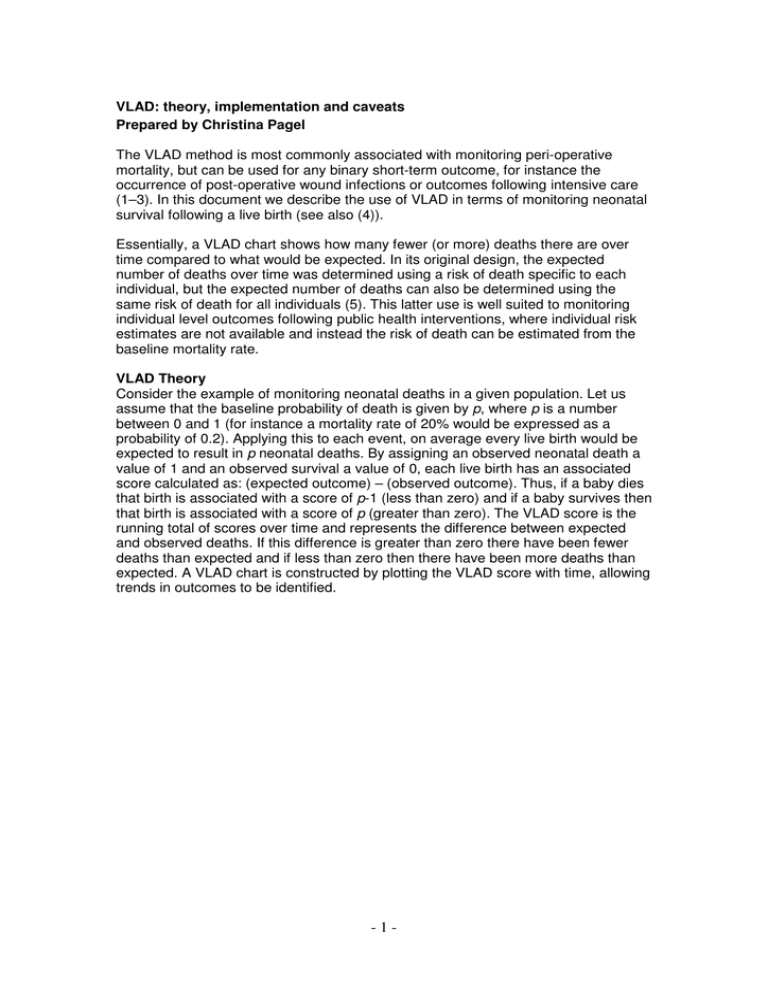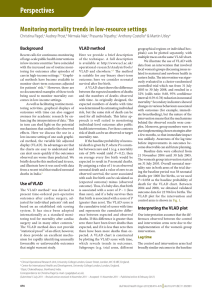VLAD: theory, implementation and caveats Prepared by Christina Pagel
advertisement

VLAD: theory, implementation and caveats Prepared by Christina Pagel The VLAD method is most commonly associated with monitoring peri-operative mortality, but can be used for any binary short-term outcome, for instance the occurrence of post-operative wound infections or outcomes following intensive care (1–3). In this document we describe the use of VLAD in terms of monitoring neonatal survival following a live birth (see also (4)). Essentially, a VLAD chart shows how many fewer (or more) deaths there are over time compared to what would be expected. In its original design, the expected number of deaths over time was determined using a risk of death specific to each individual, but the expected number of deaths can also be determined using the same risk of death for all individuals (5). This latter use is well suited to monitoring individual level outcomes following public health interventions, where individual risk estimates are not available and instead the risk of death can be estimated from the baseline mortality rate. VLAD Theory Consider the example of monitoring neonatal deaths in a given population. Let us assume that the baseline probability of death is given by p, where p is a number between 0 and 1 (for instance a mortality rate of 20% would be expressed as a probability of 0.2). Applying this to each event, on average every live birth would be expected to result in p neonatal deaths. By assigning an observed neonatal death a value of 1 and an observed survival a value of 0, each live birth has an associated score calculated as: (expected outcome) – (observed outcome). Thus, if a baby dies that birth is associated with a score of p-1 (less than zero) and if a baby survives then that birth is associated with a score of p (greater than zero). The VLAD score is the running total of scores over time and represents the difference between expected and observed deaths. If this difference is greater than zero there have been fewer deaths than expected and if less than zero then there have been more deaths than expected. A VLAD chart is constructed by plotting the VLAD score with time, allowing trends in outcomes to be identified. -1- VLAD Implementation Figure 1 - A hypothetical example where baseline probability of death is 0.1 (corresponding to a 10% mortality rate). The first 4 points on the VLAD chart are shown. A hypothetical example using neonatal mortality to illustrate the VLAD chart is shown in Figure 1. In this example, we assume that the baseline probability of death is 0.1 (corresponding to an NMR of 100 neonatal deaths per 1000 live births or 10%), so that every baby that survives is associated with a score of 0.1 and every baby that dies is associated with a score of − 0.9 . Observed Probability of Associated VLAD score outcome in death score (risk(running total of scores) order of birth outcome) date (1=death) 0 0.1 0.1 0.1 0 0.1 0.1 0.2 1 0.1 -0.9 -0.7 0 0.1 0.1 -0.6 Table 1 - Example VLAD calculation for figure 1. An observed death is allocated a value of "1" and an observed survival a value of "0". Outcomes are ordered by the chronological order of the event (in this case a live birth). Table 1 shows how the VLAD plot in Figure 1 is obtained. If, throughout the time period considered, the overall observed mortality rate matches the baseline mortality rate used in constructing the VLAD chart, then the VLAD score will tend to fluctuate around zero. This is illustrated in Figure 2, where we randomly generated 100 outcomes over an example three year period assuming a baseline probability of death of 0.1 (10%) and assigned hypothetical birthdates to each outcome. -2- Figure 2 - A VLAD chart of 100 hypothetical consecutive neonatal outcomes with a baseline probability of death of 0.1 (corresponding to a 10% mortality rate). Any set of data that contains distinct subgroups that could be usefully compared, for instance trial arms or people in different geographical regions or economic groupings, can be considered separately when calculating VLAD scores, with multiple traces produced on the same VLAD chart (Figure 3). Figure 3 - Comparing the outcomes between two groups on the same VLAD chart (this example was generated by randomly splitting the 100 cases in Figure 2 into two groups.) -3- VLAD Caveats It is important to note that the appearance of VLAD charts is very sensitive to the risk estimates used, so it is vital to consider carefully what the baseline risk should be: too high an estimate of baseline risk will give a false impression that outcomes are very good and may engender complacency, whereas too low an estimate of baseline risk will give the converse impression that there are many more deaths than there 'should' be. If outcomes improve over time, as is the case in many low and middleincome settings, it is important to review the value used for the baseline risk regularly, for instance annually. To illustrate this effect, in Figure 4 we have shown the VLAD chart for the same outcomes shown in Figure 2 assuming different baseline probabilities of death of 0.15 (green line), and 0.05 (red line). Figure 4 - Two VLAD plots for the same hypothetical observed outcomes as for Figure 2, but with different assumptions for the baseline probability of death. -4- Another aspect to consider when monitoring outcomes, in particular those in community settings, is loss to follow up. If the population lost to follow up has similar characteristics to those whose outcome is known then this does not present a problem. However, if there is reason to believe that those whose outcome is unknown experience either a significantly higher or lower mortality rate than those whose outcome is know, then we must be careful in the interpretation of the VLAD chart. Figure 5 shows the potential for misinterpretation if the mortality rates of a supposed 10% lost to follow up are very different to the observed outcomes. The outcomes shown in Figure 5 are hypothetical and generated using random numbers in Microsoft Excel. Figure 5 - This shows the potential impact of an unrepresentative sample lost to follow up. The black line shows a hypothetical VLAD chart if the observed baseline mortality rate was 10% and the observed outcomes also had an average mortality of 10%. Assuming a loss to follow-up of 10%, the green line shows what the VLAD chart would have been if those lost to follow-up had half the baseline mortality rate and were included in the analysis. The red line shows what the VLAD chart would have been if those lost to follow-up had twice the baseline mortality rate and were included in the analysis. If using VLAD charts to monitor outcomes using community surveillance or other data collection mechanisms susceptible to loss to follow up, it is important to consider the characteristics of those whose outcomes are unknown. If it is likely that these would have been worse than the average, then it is important to remember that the VLAD chart will give an overly optimistic view of outcomes. For those familiar with VLAD and other graphical monitoring methods already used in high resource clinical settings (6–9), we note that we have not included any statistical measures of uncertainty or control limits in this description of the tool. This is because we believe the method is most suited as a visual complement to standard statistical analysis of outcomes given the absence of established risk models for outcomes such as neonatal mortality in low income settings, and so we have simplified the method accordingly. We stress that VLAD is not intended to replace statistical analysis, but instead to help spot runs of unusually poor or good outcomes. -5- References 1. Sherlaw-Johnson C, Wilson APR, Keogh B, Gallivan S. Monitoring the occurrence of wound infections after cardiac surgery. J. Hosp. Infect. 2007 Apr;65(4):307–13. 2. Foltran F, Baldi I, Bertolini G, Merletti F, Gregori D. Monitoring the performance of intensive care units using the variable life-adjusted display: a simulation study to explore its applicability and efficiency. J Eval Clin Pract. 2009 Jun;15(3):506– 13. 3. Tan HB, Cross SF, Goodacre SW. Application of variable life adjusted display (VLAD) in early detection of deficiency in trauma care. Emerg Med J. 2005 Oct;22(10):726–8. 4. Pagel C, Prost A, Nair N, Tripathy P, Costello AML, Utley M. Life Adjusted Display (VLAD) for rapid monitoring of mortality trends over time in low resource settings. WHO Bulletin. 2011; 5. Vasilakis C, Wilson APR, Fiorentino F, Utley M. Does patient-specific risk adjustment lead to different conclusions on the occurrence of surgical wound infections? J. Hosp. Infect. 2009 Jun;72(2):179–81. 6. Rogers CA, Ganesh JS, Banner NR, Bonser RS. Cumulative risk adjusted monitoring of 30-day mortality after cardiothoracic transplantation: UK experience. Eur J Cardiothorac Surg. 2005 Jun;27(6):1022–9. 7. Sherlaw-Johnson C, Morton A, Robinson MB, Hall A. Real-time monitoring of coronary care mortality: a comparison and combination of two monitoring tools. Int. J. Cardiol. 2005 Apr 20;100(2):301–7. 8. Duckett SJ, Coory M, Sketcher-Baker K. Identifying variations in quality of care in Queensland hospitals. Med. J. Aust. 2007 Nov 19;187(10):571–5. 9. Clinical Practice Improvement Centre, Queensland Government. VLADs for Dummies. Australia: Wiley; 2008. -6-






